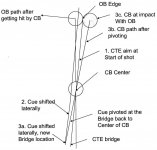Well the only way to find out about the accuracy and utility is to play someone who uses it and see if they can do more than you.
That other person might be able to "do more" for reasons unrelated to knowledge of CTE.
I was "roughed up" on RSB way back when for becoming a Houle system convert and evangelist. Oh I was told that I was eating magical mushrooms and trusting the force and a lot worse than that.
Then I went to Chicago and played in a little RSB tournament against some of the people who had been the biggest opponents of the systems.
I beat one of them playing nine ball and the other one playing one pocket using Hal's systems.
I finished second or third in that little event and the other person who finished ahead of me, Fred Agnir, is a big proponent of Hal's systems and knows them way better than I do.
Despite what Mike Page says about people just getting there through faith in oneself, i.e. the tinman comment, it's not true.
I have personally witnessed C players, APA 3s (true APA3) making shots that were far beyond their skill set when introduced to a system. Those players can't will themselves to find the correct aiming line for shots that they could never make pre-system.
But it wasn't CTE that you learned years ago. It wasn't CTE that you used in that tournament. It wasn't CTE that you taught to low-skill-level players and saw them improve instantly. Right? It was a fractional-ball aiming system. That is, one aims some reference point on the cue ball (such as its center) at some reference point on or near the object ball (such as its center, its quarter point, its edge, etc.) Fractional-ball aiming systems are full of "holes." To make all the shots, one must somehow -- consciously or subconsciously -- make adjustments from those reference aim points on some shots.
CTE is not a fractional-ball aiming system. Yes, CTE involves an initial sighting along a center-to-edge line, but the final cue-stick aim for the stroke involves no reference at all to the fractional parts of the object ball or to the degree of "overlap" between the cue ball and object ball. In fact, Hal said don't even look at the object ball after the pivot; just look at the cue ball. So, ignoring english, the basic CTE user (i.e., one who is following the mechanical prescription precisely) is always just stroking the cue stick into the post-pivot center of the cue ball with no reference to anything on the object ball, i.e., no fractional aiming.
Now, having said that it is hard to argue with Mike because he has put a lot of thought into what happens on a pool table. And with his new poolroom he has a great base of players to experiment with. I just wish that instead of playing beside Hal or watching Dave Segal he had participated.
Then we would have had Mike's thoughtful insight coupled with hands on experience with the source. As it is we have, according to Mike, only his observational viewpoint coupled with his opinion on the subject.
I'm going to bet that, after spending hours learning about CTE from Hal and Dave, Mike actually tried it himself. Safe bet?
Now, I don't mind changing my viewpoint if proven wrong. Does overspin exist? Well prior to watching Mike's videos on the subject I would have bet that it does. After watching his videos I am confident in saying that it does not.
There is a reason that the systems work. And it's definitely concrete and not faith-based. What is faith based though is having the trust to pull the trigger when the line the system puts you on feels wrong. And it feels wrong because you were doing it the wrong way previously. Not YOU personally, but those of us who use the systems know this feeling very well.
If you are running racks consistently and making all the shots you want to make then don't change a thing. I didn't think I needed to change when Hal showed up. I had no intention of listening to that old crackpot and was only humoring my friend Bob Johnson's request to meet him.
I felt like a pretty player WITHOUT Hal's systems. And I had taken a few scalps gambling locally so I wasn't a total pushover in the Denver/Ft. Collins gambling/tournament scene. I mean I wasn't a match for the top guys there but I could beat any of them in any given set if I was in gear.
After learning Hal's systems my game did in fact go to a higher level. I won a few tougher tournaments.
So from personal experience I KNOW that there is something accurate and valuable here.
If you ever do get it when it comes to CTE or any like system you won't believe the difference.


